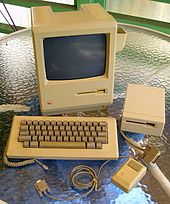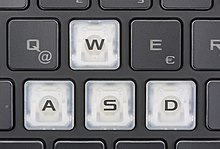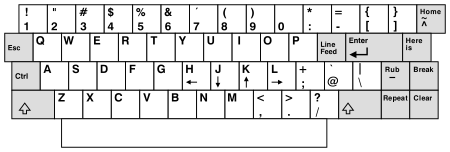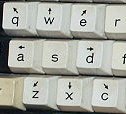Arrow keys

Arrow keysorcursor movement keysare keys on acomputer keyboardthat are either programmed or designated to move thecursorin a specified direction.[1]
The term "cursor movement key" is distinct from "arrow key" in that the former term may refer to any of various keys on a computer keyboard designated for cursor movement, whereas "arrow keys" generally refers to one of four specific keys, typically marked with arrows.[2]
Arrow keys are typically located at the bottom of the keyboard to the left side of thenumeric keypad,usually arranged in an inverted-T layout but also found in diamond shapes and linear shapes. Arrow keys are commonly used for navigating around documents and for playing games. The inverted-T layout was popularized by theDigital Equipment CorporationLK201keyboard from 1982.
Historical development
[edit]
Before thecomputer mousewas widespread, arrow keys were the primary way of moving a cursor on screen.Mouse keysis a feature that allows controlling a mouse cursor with arrow keys instead. A feature echoed in theAmigawhereby holding the Amiga key would allow a person to move thepointerwith the cursor keys in theWorkbench(operating system), but most games require a mouse or joystick. The use of arrow keys in games has come back into fashion from the late 1980s and early 1990s when joysticks were a must, and were usually used in preference to arrow keys with some games not supporting any keys.[citation needed]It can be used instead of WASD keys, to play games using those keys.
The inverted-T layout was popularized by theDigital Equipment CorporationLK201keyboard from 1982.
MostCommodore8-bit computers used two cursor keys instead of four, with directions selected using the shift key.
The originalMacintoshhad no arrow keys at the insistence ofSteve Jobs,who felt that people should use the mouse instead.[3]They were deliberately excluded from the Macintosh launch design as a forcing device, acclimating users to the newmouseinput device and inducing software developers to conform to mouse-driven design rather than easily porting previousterminal-based software to the new platform.[4]Arrow keys were included in later Apple keyboards. Early models with arrow keys but no middle section (Home, End, etc.) placed them in one line below the right-handShift keyin anHJKL-like fashion; later versions had a standard inverted-T layout, either in the middle block or as half-height keys at the bottom right of the main keyboard.
Common uses
[edit]The arrow keys are used in many applications to do different things such as:
- Moving text cursor to the right, left, previous line and next line
- Moving player's character invideo games
- Scrollingdown and up in different documents and web pages
- Changing the current selected item in a list or selecting file icon near to the current selected file in afile explorer
- Moving selected object in a drawing software
- Moving forward and backward while playingmultimediafiles
Alternative keys
[edit]Although the "arrow keys" provide one convention for cursor movement on computers, there are also other conventions for cursor movement that use entirely different keys.
5678 keys
[edit]This cursor key layout was seen inSinclair ZX80,ZX81,andZX Spectrumhome computer designs. These machines had 40-key keyboards with number keys on the top row. Each of the number keys had secondary functions requiring simultaneous use of a shift key (CAPS SHIFTin particular from Spectrum onwards) to activate them. Of these,5to8were designated as cursor control keys and were labelled with left-, down-, up-, and right-arrow symbols printed on or directly above them in a colour matching the relevant shift key. The sequence was adopted from Lear-Siegler/vi style (seeHJKLbelow). TheJupiter Acekeyboard was similar but with up and down functions swapped. The underlying character codes varied between machines, but in Spectrum and Ace designs the order of up and down keys on the keyboard reflected which had the lesser and greater numeric value.
In some software for these machines (eg. games), the unshifted5,6,7,and8keys were directly associated with direction control when they had no other purpose, as this meant less complicated keypress detection routines could be used.
Although theQL-style keyboard on laterSpectrum +and+ 128Kmodels introduced various dedicated keys including arrow keys either side of the space bar (left/right in a pair to its immediate left, and up/down to the immediate right) and removed related labels, either method produced the same signals and there was no difference between which of the alternatives was used as far as software was concerned.
WASD keys
[edit]
WASD (,AOE onDvorakkeyboards; ZQSD onAZERTYkeyboards) is a set of four keys on aQWERTYorQWERTZcomputer keyboard that mimic the inverted-T configuration of the arrow keys. These keys are most commonly used to control theplayer character's movement incomputer games.W/Scontrol forward and backward, whileA/Dcontrolstrafingleft and right.
The main reason for this arrangement is that the arrow keys are not ergonomic to use with a right-handedmouse.During the early days of gaming, this was not a problem as the mouse was not used; the arrow keys controlled both movement↑↓as well as looking around←→,with strafing done usingmodifier keys(usuallyAlt+←→). However, the introduction ofmouselook,a system that let one use the mouse to look around both vertically and horizontally, enabled the player to perform techniques such as smoothcircle strafing,which, although possible with the keyboard, was difficult to perform and resulted in jagged movement. Since the mouse was now used for looking, the←and→keys for looking would be redundant and thus were altered to become strafe keys.
The style was popularized in competitive play inQuakeand subsequentlyQuakeWorld,notably by professional playerDennis Fong,where the advantages of WASD and mouselook were recognized over a purely keyboard-based control system.[5]In the same year thatCastle Wolfensteinwas released, 1981, the gameWizardryused the AWD keys for movement in a first-person dungeon. Both the programmers ofCastle WolfensteinandWizardrywere users of the earlierPLATO systemwhere the gameMoriaused the AWD keys.[5]
Another advantage of WASD is that it allows the user to use the left-hand thumb to press thespacebar (often the jump command) and the left-hand little finger to press theCtrlor⇧ Shiftkeys (often the crouch and sprint commands), as opposed to the arrow keys which lack other keys in proximity to press.Ctrland⇧ Shiftwere chosen partly because they are larger keys and thus easier to hit, but primarily because in older systems the computer could only recognize a couple of Alpha numeric key presses, a limitation circumvented by the use ofmodifier keys.In later games, the usage of theEkey to interact with items or open up theinventorywas also popularized due to its location next to the WASD keys, allowing players to reach it quickly.
Telengard(1982) may be the first game to use WASD keys;[6]Dark Castle(1986) may be the first to use WASD keys and mouse for control.[7]Half-Life(1998) was one of the first mainstream games to use WASD by default.[5]After being popularized byfirst-person shooters,WASD became more common in othercomputer game genresas well. Many of the games that have adopted this layout use a first-person or over-the-shoulder third-person perspective. Some games that use overhead camera views also use WASD to move the camera, such as somecity-building gamesandeconomic simulation games.
ESDF keys
[edit]The ESDF variation is an alternative to WASD and is sometimes preferred because it provides access to movement independent keys for thelittle finger(Q,A,Z) which generally allows for more advanced manualbinding.Incidentally, it allows the left hand to remain in thehome rowwith the advantage of theFkey home row marker (available on most standard keyboards) to easily return to position with the index finger. Moreover, these keys are compatible with bothQWERTYandAZERTYkeyboard layouts, which is a major plus if the game is also released in France or Belgium.
Perhaps the earliest game to use ESDF wasCrossfire(1981), which used the keys for firing in multiple directions.[8]Dan "vise" Larsen fromQuakeTeam Deathmatch clan "clan Kapitol" popularized ESDF versus "WASD", explaining that the player gains three additional keys to bind theQuakegame's controls to. It is the default configuration for several games, such asTribes 2.The gameBlackthorneused a combination of arrow keys for movement and ESDF for actions.
Some players use RDFG or TFGH to give access to even more keys (SandXfor the little finger).
DCAS keys
[edit]Another alternate to the WASD shooter movement style is DCAS (sometimes called ASDC). In this configuration,DandCcontrol forward and backward motion, whileAandScontrol side-stepping (strafing). Typically theAltkey is utilized for crouching instead of the Ctrl key, as it is more easily reached when the hand is positioned for DCAS.
When Bungie's first-person shooterMarathonwas released in 1994, it featured up/down look control and the option to fully control turning and aiming by mouse (a feature later popularized by id'sQuakeasmouselook/freelook). However, it did not include a set of default controls to handle this. With WASD not yet a well-known standard, some people devised their own control schemes to handle combined keyboard movement with mouse aiming; DCAS was one such control scheme.
Like WASD, DCAS allows the player to easily utilize the left modifier keys; this is advantageous because on most keyboards, the circuitry is better at tracking multiple key-presses simultaneously if some of them are modifier keys. But unlike WASD, the position of the left hand for DCAS gameplay is very similar to the left hand's position on the home row keys. This is very comfortable for right-handed players and seen as the primary advantage over using WASD, but it is ill-suited for left-handed mousing.
IJKL keys
[edit]Two early games that used IJKL wereCrossfire[8](1981) andLode Runner(1983).
IJKL is used by a growing number ofbrowser games.These games cannot use the arrow keys because many browsers' windows will scroll if the arrow keys are used, thus hindering gameplay. This is a problem specific toDHTML/JavaScriptgames. IJKL, like WASD, are arranged in an ergonomic inverted T shape, and, since they are used by the right hand, adjustment is easy for people who commonly use the arrow keys.
Also, in many games that also use the WASD keys, the IJKL keys are sometimes used as a secondary player control for games that have multiplayer.
Devil May Cry 4byCapcomutilizes IJKL as the player's action keys (such as Melee Attack, Ranged Attack, Special Attack etc.) as an alternative to mouse-driven actions.
IJKM keys
[edit]Some older computer games, especially those on 8-bit platforms, often had the combination IJKM used as the standard control key combination, which was more logically arranged, if far less ergonomic than an inverted-T. In addition, on theApple II,special support existed in ROM forEscape mode.At theApplesoft BASICprompt, using the right and left arrow keys to move the cursor would add/remove characters the cursor passed over to/from the input buffer. Pressing theEsc keyentered a mode where pressing theI,J,KorMkeys would move the cursor without altering the input buffer. After exiting this mode by pressing Escape again, normal behavior would resume. This made it easy to edit lines of BASIC code by listing them, then re-inputting them with edits interspersed.
AZ keys
[edit]TheApple IIandApple II Plusoriginally had left and right arrow keys but no up and down arrow keys. Many programs written for these computers usedAandZto substitute for the missing up and down keys. The IJKM combination was also popular on these computers. Another fairly common variant on these machines was the combination ofRETURNand/(slash) with the left and right arrows, as those four keys roughly form a diamond on the keyboard; while the right⇧ Shiftkey would be in the more natural position for "down", pressing⇧ Shiftalone was not detectable by software on an unmodified Apple II or Apple II plus. All these keys fell somewhat out of favor after the release of theApple IIe,which had a full set of arrow keys.
HJKL keys
[edit]
HJKL is a layout used in theUnixcomputer world, a practice spawned by its use in thevitext editor. The editor was written byBill Joyfor use on aLear-SieglerADM-3Aterminal, which places arrow symbols on these letters, since it did not have dedicated arrow keys on the keyboard. These correspond to the functions of the corresponding control charactersCtrl+H,Ctrl+J,Ctrl+K,andCtrl+Lwhen sent to the terminal, moving the cursor left, down, up, and right, respectively.[9](TheCtrl+HandCtrl+Jfunctions were standard, but the interpretations ofCtrl+KandCtrl+Lwere unique to the ADM-3A.) This key arrangement is often referred to as "vi keys". HJKL keys are still ubiquitous in newly developed Unix software even though today's keyboards have arrow keys. They have the advantage of letting touch-typists move the cursor without taking their fingers off of the home row. Examples of games that use HJKL are the text-based "graphic" adventures likeNetHack,theRogueseries, andLinley's Dungeon Crawl.It is also used by some players of theDance Dance RevolutioncloneStepMania,where HJKL corresponds directly to the order of the arrows.Gmail,Google Labs' keyboard shortcuts and other websites use J and K for "next" and "previous".[10][11][12]
SDF-SPACE and ASD-SPACE
[edit]Another old-style variation that spawned from games likeQuakewas the SDF-SPACE layout. In this layout,S= turn left,D= forward,F= turn right, space = backpedal,E= strafe left andR= strafe right. This layout allows the player to aim with the mouse while strafing (sidestepping), turning and running or backpedaling all at once creating slightly more complex movements. This variation is not favoured any longer for two main reasons. First, because many players deem the turn commands useless because the mouse can act as a turning device, and so they assignSandFto the sidestep commands and leave the turn commands unassigned. The second, and probably more prominent reason is, in assigning both the turn and strafe commands, performing movements and dodges can be much more confusing, so newcomers tend to not prefer this key setup. Though no longer widely used, many FPS veterans and tournament players still employ this key setup.
This variant adopted to newer games using mouse-look doesn't really need worry about the turn left and turn right keys. InsteadS= strafe left,D= strafe right,A= backpedal, and space orF= forward. This is a more natural feel on the keyboard as your fingers rest on thehome row.The comfort and usability points from ESDF apply here. Notice that jump is left out, that is because in games like Quake jump was usually MOUSE2. With more alternate fire and aim-down-sights oriented games today you may have to play withF,SPACE, and MOUSE2 on what you want them to do.
A similar layout is ASD-SPACE. Commonly used in 2D-basedfighting games,ASD-SPACE mapsA,S,andDto "left", "down", and "right" movement, while the spacebar is used for "up" (jumping). This allows an easier access to "360 degree" motions than a normal inverted-T layout, as well as being more ergonomic than simply placing all directions in a single row (ex. ASDF). There is even a "stickless"arcade controllerbased around the concept, called the Hitbox.[13]
WQSE keys
[edit]Another, close, variation is the WQSE combination, which follows the belief that the index and ring fingers' natural and more ergonomic positions when the middle finger is onWareQandErather thanAandD,respectively. This can be attested to by the fact that the arrow keys were partly designed in the inverted-T shape in order to avoid having the side buttons possibly directly underneath other keys.[citation needed]It also has the advantage that there is less distance needed to travel to reach the number keys. For similar reasons, some gamers use the WQSD combination (which is WASD with theAkey moved up toQ,or WQSE with theEmoved down toD). For players who prefer to keep the keyboard centered on the body, this results in less wrist rotation, as it places the index finger naturally over theDkey when the left arm rests down to the left of the keyboard. Another variation is EWDF, which is the same shifted right one key, as in ESDF. SAZD is a slight variation on WQSE and WQSD, in that it is both ergonomic and rotated, but gives the fingers closer proximity to the⇧ Shiftand SPACE keys.
QAOP keys
[edit]QAOP, sometimes called OPQA, dates back to theZX Spectrum.The O/P keys were used for left/right movement, and the Q/A keys for up/down or forward/backwards movement. With SPACE being located at the bottom right of the original rubber-keyed Spectrum, theMor sometimesNkey would be used for fire/action; on later models the SPACE bar would be used.
QAOP had its own variations, such as ZXKM or WELP. ManyBBC Microgames used the keysZX*?respectively for left, right, up, and down (with "*" being the key above and right of "?", where "@" is onmodern UK keyboards). In each case, one hand controls left/right, and the other hand controls up/down movement. A further variation is used when two players use the keyboard at the same time; for example,Gauntletuses the combination 1QSD for Player 1, and 8IKL for Player 2.
ESDX keys
[edit]The ESDX keys (known as the "cursor movement diamond" ) were used in theWordStarword processor and related applications, in combination with theControl key.These keys were also used, and hadarrows printed on themon theTI-99/4Acomputer.
Numpad keys
[edit]TheModel F keyboardthat came with the originalIBM PCdidn't have dedicated arrow keys, and instead used the 8426 keys withNum Lockturned off. Therefore this was the scheme used by the earliestDOSgames.
The numpad or number pad keys are used quite often, but are used mostly indriving simulatorgames. This is mainly because these games usually have quite a large number of keys needed to control the vehicle properly and the number pad will have plenty of keys for that particular use. Another reason this is commonly used is because left-handed players will find this a more comfortable position than the IJKL keys (see above), and the number pad has fewer keys around it, thus it is less likely the player will hit the wrong key by mistake.
WAXD (including QEZC)
[edit]
Another variation is WAXD, using either 4 or 8 keys surrounding the "s" key. Eight directional arrows were printed on the keysets ofPLATO terminalsdeveloped in the 1960s and 1970s, and many games (includingEmpire,Dogfight, and more than a dozen dungeon games such asAvatar) utilize this layout. The TUTOR language display editor, character set (bitmap) editor, and line set editor also use these keys on that system and its successors. For ballistic targeting, key combinations (e.g. "we", "de", etc.) are used to get angles in multiples of 22.5 degrees. In many programs, the "s" key is often used to either "select" or "shoot", depending upon the application.
This layout also appears on the numeric keypads of some keyboards, using 8462 (including 7913).
Less common variations
[edit]Vaguely related is theZXClayout, used in many freeware games, and a common setup foremulationand older 2D gaming using a keyboard.[citation needed]
A few games from the 1980s, such as thePhantasieseries,use the "3WES" layout, which forms a diamond onQWERTYkeyboards. In this layout, three of the four keys happen to correspond to the compass directions "West", "East" and "South". These games usually assign both "N" and "3" to "North".
AZERTYusers will use the "ZQSD" combination instead of "WASD", since those are the keys in place of WASD on a QWERTY keyboard. Depending on the configuration, "QAOP" may either still work or be vertically inverted. On theDvorak keyboard layout,"WASD" is ",AOE".
Left-handedplayers may use thenumeric keypadinstead.
A somewhat uncommon variant isYGHJwhich while requiring the keyboard to be turned slightly clockwise, can result in the thumb resting comfortably upon the rightAltkey and the little finger resting onC.This can be useful in games that utilize both jump and sprint functions as it allows the fingers to rest on smaller keys than⇧ Shiftand Space. TheYGHJconfiguration also places the hand closer to the center of the QWERTY section of the keyboard, potentially opening up the entire board to customkeybindings.[citation needed]

The gameQWOPuses the control scheme "QWOP" to control Qwop's arms and legs. theQandWkeys control Qwop's thighs while theOandPkeys control Qwop's calves making an intentionally difficult control system as a result.
Layouts such asShift Z Ctrl X,where⇧ Shiftis up andCtrlis down, allow all direction keys to be used in any combination, without the delay of changing finger position. But the use of modifier keys can be problematic, as some games do not allow mapping of these keys.
ProfessionalCounter Strike:Global Offensiveplayer Fashr is known to use somewhat unorthodox keybindings. Using the Right Mouse to move forward, Semicolon to move backwards, Comma for strafing left and a Full Stop to strafe right.[14]
See also
[edit]Notes and references
[edit]- ^'Inside Macintosh', by Caroline Rose, Bradley Hacker, Apple Computer, Inc. Published 1985, Addison-Wesley Pub. Co.ISBN0-201-05409-4.Original from the University of Michigan; Digitized Nov 16, 2007.
- ^Visual editing on unix By B. Srinivasan, K. Ranai Published 1989 World Scientific Text editors (Computer programs) 182 pagesISBN9971-5-0770-6
- ^"Apple's Steve Jobs Hates Buttons".CBS News.
- ^"History of computer design: Macintosh".Retrieved2013-01-21.
- ^abcWilde, Tyler (2016-06-25)."How WASD became the standard PC control system".PC Gamer.
- ^Harbron, Robin (2020-10-29).Time Machine? Or VIC-20 24KB RAM 7 Cartridge Expander?.8-Bit Show and Tell – via YouTube.
- ^Moss, Richard (2018-03-22)."The making of Dark Castle: An excerpt from The Secret History of Mac Gaming".Gamasutra.Retrieved2018-03-25.
- ^abTommervik, Art (January 1982)."Crossfire".Softline.p. 15.Retrieved13 July2014.
- ^Tenth Anniversary ADM 3A Dumb Terminal Video Display Terminal User's Reference Manual,p. 1-5 (13 of 54).
- ^"Gmail keyboard shortcuts".
- ^"Google Experimental Search".
- ^"Bloglines keyboard shortcuts".
- ^"Fighting Game Button Controllers and Joysticks | Hit Box – Hit Box Arcade".
- ^"Fashr's 'different' CS: GO settings, crosshair and viewmodel settings".Esports.gg.Retrieved2023-01-07.
External links
[edit]| Esc | F1 | F2 | F3 | F4 | F5 | F6 | F7 | F8 | F9 | F10 | F11 | F12 | PrtScn/ SysRq |
Scroll Lock |
Pause/ Break |
|||||||||
 |
Insert | Home | PgUp | Num Lock |
∕ | ∗ | − | |||||||||||||||||
| Delete | End | PgDn | 7 | 8 | 9 | + | ||||||||||||||||||
| 4 | 5 | 6 | ||||||||||||||||||||||
| ↑ | 1 | 2 | 3 | Enter | ||||||||||||||||||||
| ← | ↓ | → | 0 Ins |
. Del | ||||||||||||||||||||
